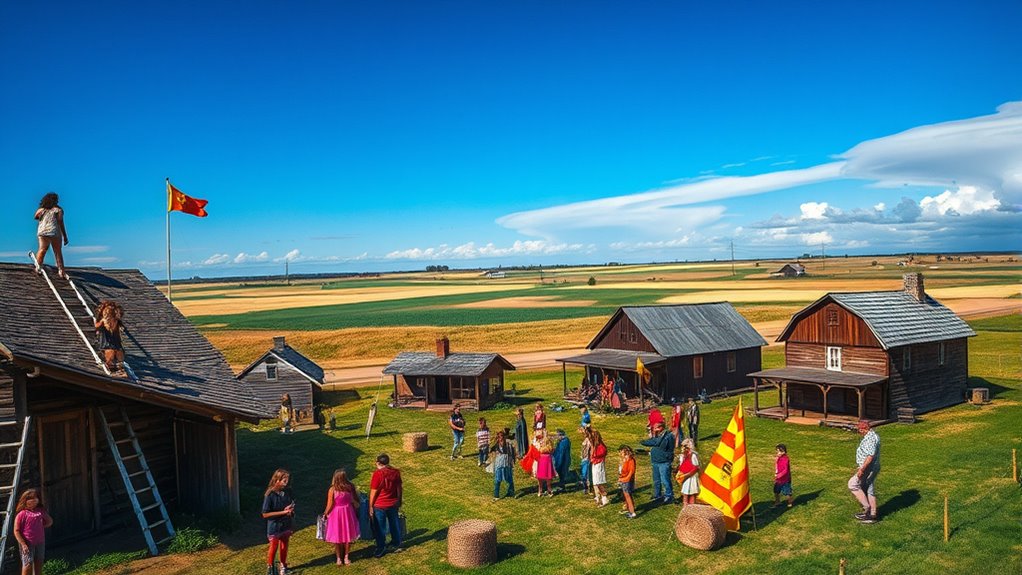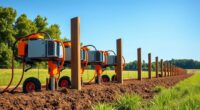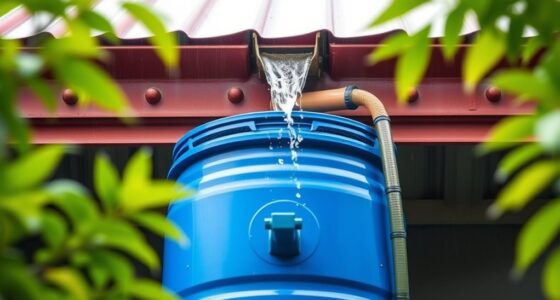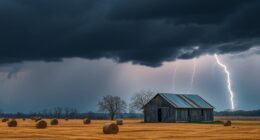To create effective fire‑escape and tornado drills for your rural home, start by evaluating unique risks like outbuildings, trees, and open fields. Choose clear, accessible routes away from hazards such as power lines or flood-prone areas, and practice multiple pathways. Customize your drills to match your property’s layout and natural features. Regularly train your family and review plans to adapt as your home changes. Continuing with this plan will help guarantee everyone’s safety during emergencies.
Key Takeaways
- Identify rural-specific hazards like outbuildings, dense trees, and open fields to tailor fire and tornado response plans.
- Select and regularly practice multiple, accessible escape routes that avoid obstacles and environmental dangers.
- Map out escape paths from all property areas, including barns and sheds, considering terrain and natural features.
- Assign clear roles to family members during drills, simulating realistic fire and tornado scenarios for better preparedness.
- Review and update safety plans annually, incorporating lessons learned and changes in property or local risks.
Assessing Unique Risks and Planning Your Drills
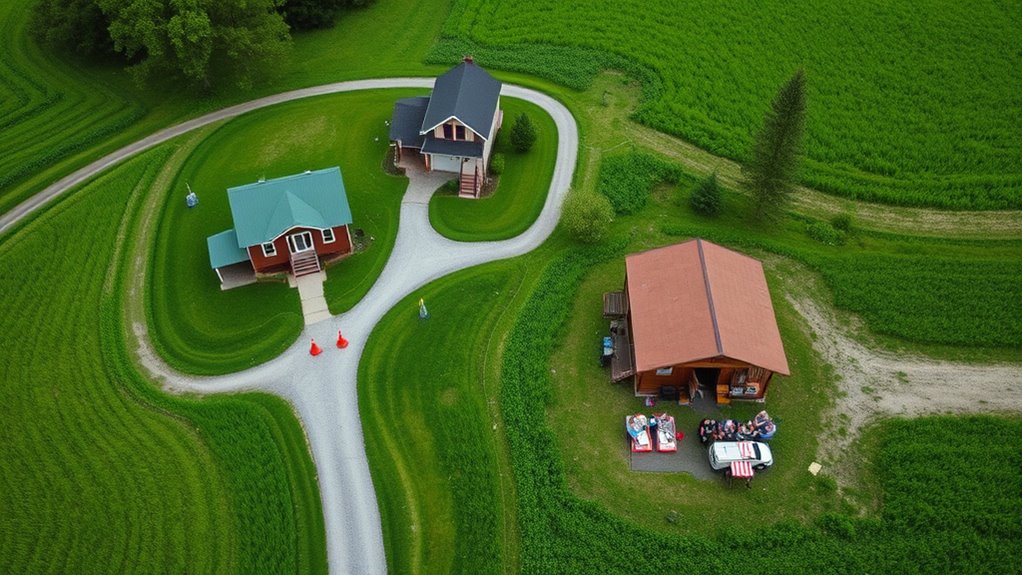
Before you can create effective fire-escape and tornado drills, you need to identify the specific risks your rural home faces. Rural homes often have unique hazards, like outbuildings, dense trees, or open fields, that influence your safety plan. Consider nearby natural threats, such as frequent storms or fire-prone areas, and structural risks like old wiring or limited escape points. Take a walk around your property to identify potential obstacles, hazards, and safe zones. Think about the location of windows, doors, and accessible exits. Understanding these risks helps you tailor your drills to reflect real dangers, ensuring everyone knows what to do quickly and safely during an emergency. Proper planning starts with knowing your environment inside and out, including projector technology that can be used for emergency training or communications in rural settings.
Selecting Safe and Accessible Escape Routes

Once you’ve identified the hazards and safe zones around your property, the next step is to choose escape routes that are both safe and easy to access. Look for paths that lead away from potential dangers like downed power lines, fallen trees, or flood-prone areas. Make sure routes are clear of obstacles, such as debris or overgrown vegetation, that could slow your escape. Select multiple routes if possible, so you have options if one becomes unsafe. Ensure these paths are well-lit and easy to navigate, even in low visibility conditions or at night. Practice walking them to confirm they are quick and straightforward. Clear any obstructions regularly to keep your escape routes reliable in an emergency. Incorporating attention and focus into your planning can significantly enhance the effectiveness of your escape strategy.
Customizing Drills for Rural Living Conditions
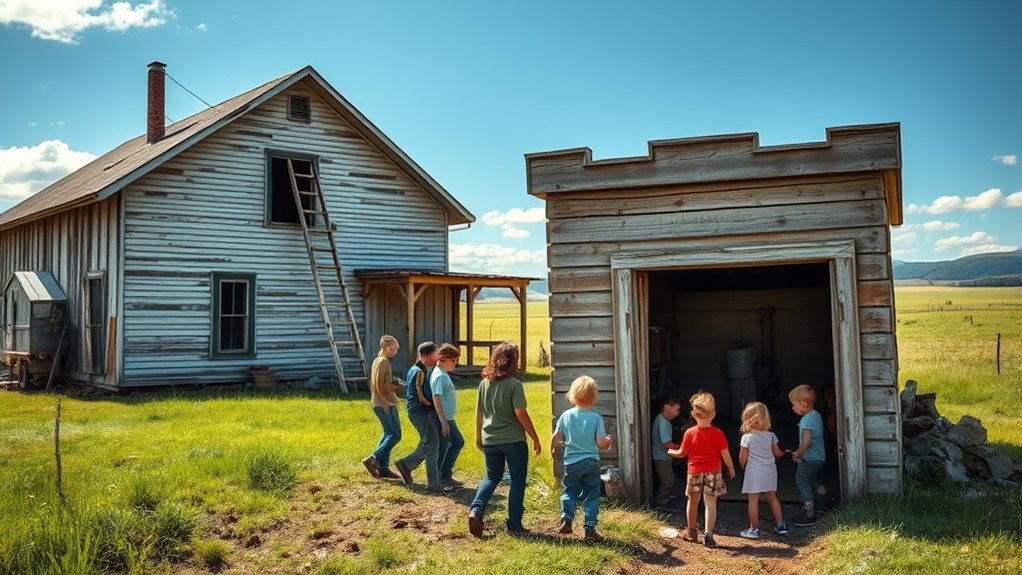
Rural living presents unique challenges that require tailored fire-escape and tornado drills. You might have larger properties, private roads, or outbuildings that complicate evacuation plans. To customize your drills, consider your specific landscape and home layout. Map out multiple escape routes from each part of your property, including barns or sheds, and ensure everyone knows them. If you live near wooded areas or open fields, plan for safe distances and clear paths that avoid obstacles. Incorporate local hazards into your drills, like nearby water bodies or uneven terrain. Regularly review and adjust your plan as needed, especially if you make changes to your property or add new structures. Using data analytics can help identify potential risks and improve your evacuation strategies. Customizing your drills ensures they’re practical and effective for your rural living conditions.
Training Family Members and Practicing Regularly

Training family members and practicing regularly are essential steps to guarantee everyone knows how to respond quickly and safely during emergencies. Regular drills build confidence, reduce panic, and ensure familiarity with escape routes. To make these practices effective, consider these key points:
- Assign clear roles so each person knows their responsibility during an emergency
- Use realistic scenarios to simulate actual conditions
- Review and discuss the drills afterward to identify improvements
- Keep practice sessions brief but frequent to maintain engagement and retention
- Incorporating family dynamics understanding can enhance cooperation and effectiveness during drills
Reviewing and Updating Your Safety Plans
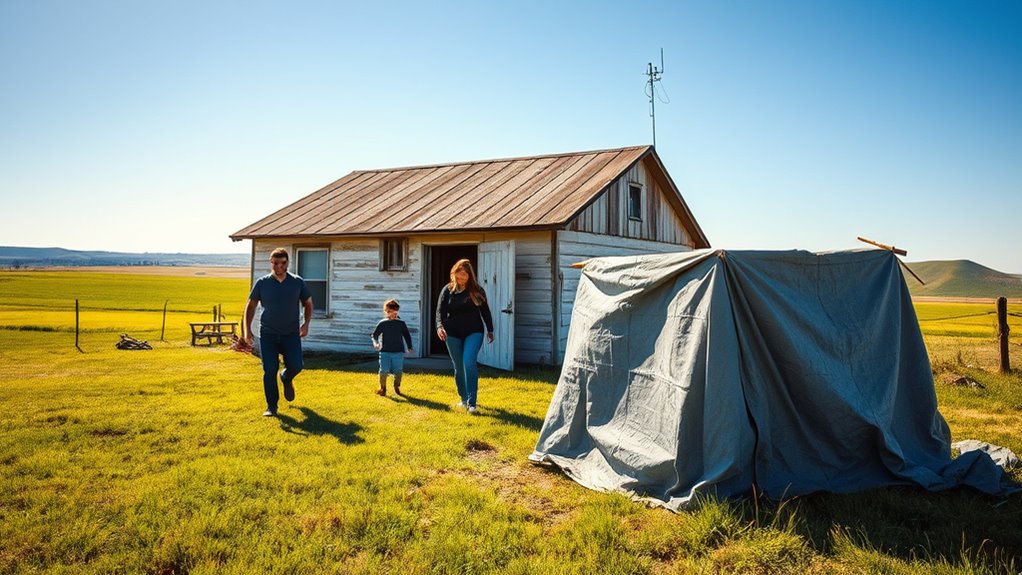
Regular practice helps your family remember emergency procedures, but it’s equally important to review and update your safety plans regularly. Over time, circumstances change — new family members, updated home layouts, or new hazards in your area. Schedule a review at least once a year to ensure your plans are current. Check that everyone knows their roles and routes, and update contact information and emergency supplies if needed. Discuss recent drills with your family, noting what worked and what didn’t. Incorporate lessons learned to improve your response. Keeping your safety plans up-to-date guarantees everyone stays prepared and confident. Regular reviews help identify gaps before an emergency occurs, making your family’s safety a continuous, proactive effort. Understanding the importance of risk mitigation can further enhance your preparedness efforts.
Frequently Asked Questions
How Can I Involve Neighbors in Community-Wide Emergency Drills?
You can involve neighbors in community-wide emergency drills by organizing meetings to discuss plans and set a schedule. Encourage everyone to share their ideas and concerns, creating a sense of teamwork. Use local social media groups or community boards to spread the word and invite participation. Offer clear instructions and practice sessions so everyone feels confident. Active engagement fosters trust and ensures everyone knows what to do during an emergency.
What Emergency Supplies Should Be Included in Rural Fire‑Escape Kits?
Did you know a well-stocked fire-escape kit can save lives? You should include essentials like a flashlight, batteries, a first aid kit, sturdy gloves, a whistle, a multi-tool, bottled water, non-perishable snacks, and a portable phone charger. Consider adding a dust mask, blankets, and important documents in a waterproof container. Regularly update your supplies and keep the kit accessible to guarantee you’re prepared for emergencies.
How Do I Adapt Drills for People With Mobility Challenges?
You should tailor your drills by including accessible escape routes and devices like stair lifts or ramps. Practice using mobility aids and guarantee everyone knows how to operate them quickly. Assign specific roles to those with mobility challenges, and conduct regular practice sessions to build confidence. Make sure your emergency plan accounts for slow-moving individuals, so everyone can evacuate safely and efficiently during an actual emergency.
Are There Local Resources or Programs to Assist With Safety Planning?
You can find local resources or programs by contacting your community emergency management office or local fire department. Many areas offer free safety planning assistance, including customized drills for residents with mobility challenges. Additionally, check with local non-profits or senior centers, as they often have programs or volunteers who can help you develop and practice effective safety plans tailored to your needs. Don’t hesitate to ask for the support you deserve.
How Can Technology Enhance Rural Emergency Preparedness and Response?
Imagine your home glowing with alerts and real-time updates; technology makes this possible. You can set up smartphone alerts for severe weather, use GPS to find the quickest escape routes, and install smart sensors that detect smoke or gas leaks early. These tools act like an invisible safety net, guiding you swiftly through emergencies. Embracing technology transforms your response, helping you stay calm and prepared when it matters most.
Conclusion
By regularly practicing your fire escape and tornado drills, you’ll be prepared like a modern-day Noah, ready to weather any storm. Just as he trusted his ark, trust your plan to keep your family safe. Remember, safety isn’t a one-time event but an ongoing journey—so stay vigilant and adapt your drills as needed. With dedication and preparation, you’ll navigate emergencies with confidence, turning chaos into calm when it matters most.

